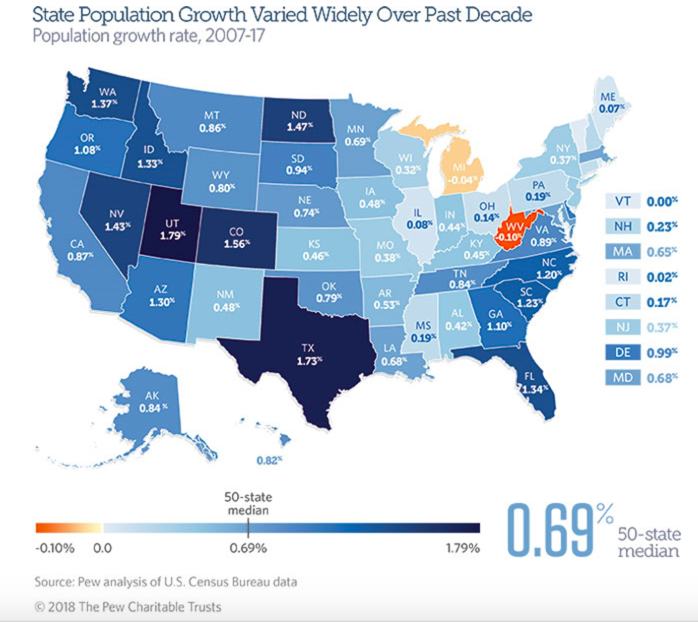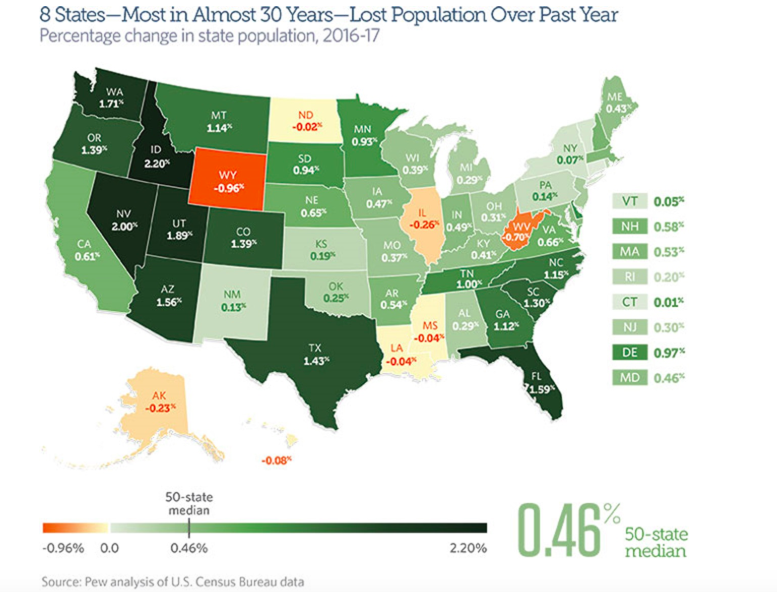Connecting state and local government leaders
A new analysis looks at population growth across the states, which is tied to state finances. Only two states saw a population drop over the last decade.
This article was originally published by States' Fiscal Health, an initiative of The Pew Charitable Trusts, and was written by Matt McKillop and Daniel Newman.
All but two states—Michigan and West Virginia—saw their population rise in the past decade. Continuing a long-term trend, however, growth nationally and in a majority of states is estimated to have slowed over this period, which overlapped with the Great Recession. Eight states—the most in almost 30 years—lost residents in 2017 alone. Population trends matter to both state government finances and economic growth.
Western and Southern states dominated the ranks of the fastest-growing populaces in the 10 years ending on July 1, 2017. Topping the list were Utah, Texas, Colorado, and North Dakota, which each added people at more than twice the median rate and also were among the top five in economic growth during the decade since the recession began.
Utah’s population expanded by more than 504,000 since mid-2007, or the equivalent of 1.79 percent a year, and Texas’ grew by nearly 4.5 million, or 1.73 percent a year. Utah added fewer people but outranked Texas based on their 10-year growth rates, which measure the constant pace that population would have had to change each year since 2007 to reach its latest count. The median rate of growth among states was 0.69 percent a year.
In contrast, all but two of the 15 states that had the lowest population growth are in the Northeast and Midwest, including Michigan. It had about 39,000 fewer residents in 2017 than in 2007, losing the equivalent of 0.04 percent a year. For a half-century, people have gravitated away from these regions and toward Sun Belt states because of employment opportunities, lower costs of living, and warmer climates.
West Virginia shrank at an even faster rate than Michigan over the past 10 years. It lost about 18,000 people, or the equivalent of 0.1 percent a year.

U.S. population growth has slowed nearly every year since 1992, though growth trends among states vary. The U.S. Census Bureau forecasts that growth in many states will remain tepid because of declines in fertility rates alongside higher death rates, as populations age, as well as falling rates of international migration. The number of births in the U.S. in calendar 2017 was the lowest in 30 years, according to provisional data from the National Center for Health Statistics.
State populations grow or shrink depending on the net effect of births, deaths, and migration to and from other states and abroad, including documented and undocumented people. Population change measures the difference between all new residents—babies and newcomers from other states and outside the U.S.—and those who died or moved away.
In the year ending July 1, 2008, the typical state’s population—reflected by the 50-state median—grew by 0.89 percent. That rate fell every year over the rest of the decade, except for two increases in 2012 and 2017. Two-thirds of states grew more slowly in the second half of the past decade than during the first half.
The median growth rate in the year ending July 1, 2017 was 0.46 percent, the second slowest this century behind 2016. The sluggish rate was driven by eight states with falling populations—the largest number of states to lose population in a single year since 1989.

State officials study population trends, in addition to other measures, to forecast revenue streams and residents’ demands for services for budgeting purposes and long-term fiscal planning. The size of a state’s population, and annual changes, also factor into how much it will receive from some federal grants.
Ten-year growth rates illustrate major trends that have helped shape a state’s economic and fiscal conditions, while growth over the past year sheds light on shifts that affect near-term revenue collections and spending.
State highlights
A comparison of 10-year population trends, based on each state’s constant annual growth rate between July 2007 and July 2017, shows:
- After Utah and Texas, the next fastest-growing states were Colorado (with increases equivalent to 1.56 percent a year), North Dakota (1.47 percent), Nevada (1.43 percent), Washington (1.37 percent), and Florida (1.34 percent).
- Apart from West Virginia and Michigan, which had declines, the states with the slowest population growth were Vermont (0.0 percent), Rhode Island (0.02 percent), Maine (0.07 percent), and Illinois (0.08 percent).
- Among the 15 slowest-growing states over the past decade, the only two not in the Midwest or Northeast were West Virginia—where the population fell by 0.10 percent a year—and Mississippi, whose annual growth rate of 0.19 percent was the ninth-slowest in the nation. Both were out of step with the fast-growing South.
- North Dakota (1.47 percent) was an exception in the slow-growing Midwest. Since 2007, it had the fourth-fastest rate as its oil boom attracted out-of-state workers. However, after leading the nation in annual growth every year since 2012, its population virtually held still in 2016 and contracted a bit in 2017 in the wake of falling oil prices.
More recently, population change from July 2016 to July 2017 shows:
- Idaho grew the fastest, adding 2.20 percent more residents. Next fastest were Nevada (2.0 percent), Utah (1.89 percent), Washington (1.71 percent), Florida (1.59 percent), Arizona (1.56 percent), and Texas (1.43 percent).
- The eight states that lost population were Wyoming (‑0.96 percent), West Virginia (‑0.7 percent), Illinois (‑0.26 percent), Alaska (‑0.23 percent), Hawaii (‑0.08 percent), Mississippi (‑0.04 percent), Louisiana (‑0.04 percent), and North Dakota (‑0.02 percent).
- West Virginia has lost population for five years in a row and Illinois for four years. Losses in each over the past year were driven by exiting residents, and West Virginia also had more deaths than births.
- Connecticut (0.01 percent) and Vermont (0.05 percent) grew for the first time in four years, though the increases were the least among expanding states.
- Populations in 29 states grew more slowly from 2016 to 2017 than their growth rate over the past decade. After Wyoming (with a difference of ‑1.76 percentage points), North Dakota (‑1.49 points) and Alaska (‑1.07 points) throttled back the most compared to their decade-long pace.
- On the other end of the spectrum, 21 states grew more quickly than their 10-year paces. Idaho (0.87 percentage points faster), Nevada (0.57 points), and Maine (0.36 points) sped up the most. Maine grew faster in both 2016 (0.18 percent) and 2017 (0.43 percent) than in any year since 2008.
Effects on state finances
Population trends are tied to states’ economic fortunes and government finances, and are therefore useful for understanding both. The states with the fast-growing populations typically have strong labor force growth, which fuels economic growth and helps generate tax revenue to fund increased demands for services. The reverse is usually true for states with shrinking or slow-growing populaces.
Population trends both influence and are influenced by economic growth. More people usually means more workers and consumers adding to economic activity as they take jobs and buy goods and services, which generates more tax revenue. A growing economy, in turn, can attract even more workers and their families. North Dakota, for example, experienced a population boom from 2011 to 2015 as workers sought jobs created after technological changes unlocked previously unrecoverable oil reserves.
On the other hand, a shrinking populace can be both a cause and an effect of weakened economic prospects. Connecticut, Illinois, Maine, Rhode Island, and West Virginia all fall near the bottom of both population and economic growth over the past decade. Less economic growth can limit state revenue collections.
Population also affects the spending side of a state’s ledger. A surge in new residents can heighten the need for infrastructure, education, and other services. A smaller populace can translate into lower outlays but also means fewer residents to help cover the costs of long-standing commitments, such as debt and state employee retirement benefits.
Population is just one factor underpinning a state’s finances, which also are shaped by policy decisions on tax collections and spending as well as factors outside a state’s borders and lawmakers’ control, such as commodity prices.
Year-by-year trends
Tracking year-by-year changes over a decade helps differentiate experiences among states with similar 10-year growth rates and can identify inflection points. (See the “Year by year” tab.)
For instance, West Virginia and Michigan were the only states whose populations were smaller in 2017 than in 2007, but their trends are heading in opposite directions. West Virginia’s population shrank in each of the past five years, while Michigan’s grew in each of the past six years.
Hawaii gained nearly 112,000 people since mid-2007, with an annual growth rate of 0.82 percent, faster than the typical state. Yet growth has slowed each year since 2014 and declined in 2017.
To further understand the fiscal and economic impact of population change, fiscal analysts and demographers also study the shifting age and income mix of a state’s residents. The aging and retirement of the baby boom generation—born between 1946 and 1964—will have economic and fiscal consequences.
Download the data to see individual state trends from 2007 to 2017. Visit The Pew Charitable Trusts’ interactive resource Fiscal 50: State Trends and Analysis to sort and analyze data for other indicators of state fiscal health.

NEXT STORY: State Sales Tax Collections Finally Move Into the Internet Age



